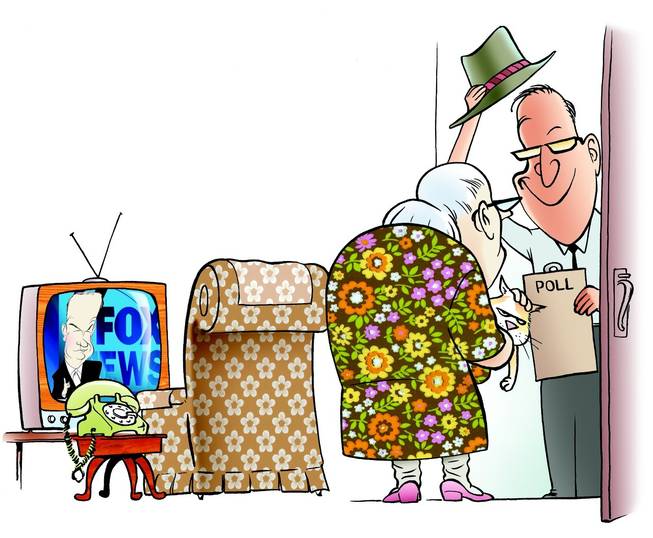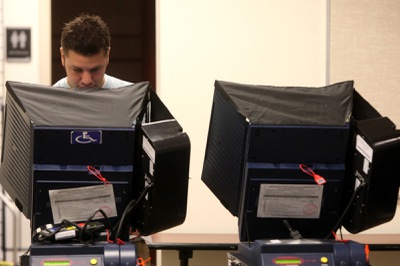Thursday, Nov. 4, 2010 | 2 a.m.
Sun archives
- Poll shows Angle, Reid close in Nevada Senate race (10-29-2010)
- Jon Ralston: The consequences of flawed public polling (10-8-2010)
- Harry Reid inching ahead of Sharron Angle, new poll finds (9-25-2010)
- Polls: Harry Reid grabs lead over Sharron Angle (7-16-2010)
- Poll: Either GOP challenger could topple Harry Reid (8-23-2009)
- Margin of error is polls’ fine print (10-14-2008)
Reader poll
The Las Vegas Review-Journal’s final polls in the two most closely watched Nevada races wound up having about as much predictive power as the Old Farmer’s Almanac in forecasting the winter snowfall.
One of its polls, published Oct. 29, showed Republican Sharron Angle beating Sen. Harry Reid 49-44. Four days later, Reid wound up winning 50-45.
Another poll, published on Halloween, had Republican Joe Heck beating Rep. Dina Titus 53-43. Heck won by less than 1 percentage point.
Both polls drove news coverage in Nevada and nationally, framing the political narrative as one in which Republicans had both races firmly in hand in the final days.
In fairness, other end-of-the-race polls, including those conducted by CNN and Rasmussen, showed similar results in the Reid-Angle race.
In the Titus-Heck contest, on the other hand, the R-J poll was viewed with skepticism by both campaigns and analysts of all stripes.
This isn’t the first time the R-J, which uses Washington-based Mason-Dixon Polling & Research, has published polls that ran far afield of Election Day results. And, the results always seem to skew Republican.
In 2008, the R-J’s final poll had Barack Obama beating John McCain in Nevada by 4 percentage points. Obama won by 12.5. A late poll in 2004 had President George W. Bush beating Sen. John Kerry by 10. Bush won by 3.
The R-J and its pollster were criticized in October 2008 when it polled in two of Nevada’s congressional races, using fewer than 300 respondents in each race. A polling expert with Pew Research Center said he had never seen published polls with such small sample sizes. Polls with fewer respondents are cheaper to conduct, but also mean a greater margin of error.
These polls can matter because, as one Democratic operative complained, they can have the effect of self-fulfilling prophecy, depressing campaign donors and volunteers and infusing Democratic voters with apathy.
A call to Mason-Dixon was not returned.
Pollsters note that laymen often misunderstand the concept of “margin of error.” For instance, in the Reid race, the margin of error — determined by an equation related to the number of respondents — was plus or minus 4 percentage points. In other words, Reid could have been as high as 48 and Angle as low as 45. But Reid scored 50 percent of the vote.
Pollsters also note that their work, even the polls on the last weekend before Election Day, are not intended to be predictors, but, rather, “snapshots in time” because public opinion can change on a dime.
Sherman Frederick, publisher of the R-J, said he was dissatisfied with the result.
“We pay for the poll, and we expect accuracy,” Frederick said. “We obviously didn’t get the kind of accuracy we expected, and we’re going to have to ask some questions about where the breakdown occurred.”
He has no plans to fire Mason-Dixon, he said.
R-J critics think they know exactly where the breakdown occurred: Its pollster, relying on old-fashioned random dialing to land lines, doesn’t account for voters who only have cell phones, and undercounts Hispanic voters who may be reluctant to participate in surveys. Both groups are heavily Democratic.
“They’re not drawing a population that looks like the electorate,” said Dave Damore, a UNLV political scientist who studies public opinion data.
Pamela Gallion, director of UNLV’s Cannon Survey Center, said, “During the (election) cycle, I was reading the paper and the polls and came in and said to the staff, ‘I wish we had the money because I know we would get different results.’ ”
Gallion cited a recent report from Pew Research Center showing that a quarter of all Americans can be reached only by cell phone. They tend to be younger, a demographic dominated by Democrats. Pew estimated that the land line bias gave Republicans 4 to 6 percentage points in polls.
Gallion said a random land line phone survey will yield 9 to 14 percent Spanish speakers willing to complete a survey. But in 2008, they made up 15 percent of the electorate, and this year perhaps higher.
The Cannon Survey Center now spends the extra money required to reach cell-only and Hispanic respondents, a process that is costly and time-consuming.
Frederick said penny-pinching is not to be blamed; the paper spent lots of money on polls this cycle, he said, a fact not lost on the paper’s readers, who got used to seeing frequent polls. In the Senate and governor races, for instance, the newspaper published results of eight polls from July 16 through Oct. 29, twice as many R-J polls of major races as in 2008 when Democrats were faring better.
The publisher said he was open to the possibility that cell-only and demographic flaws had skewed the paper’s polls and need fixing.
“Maybe Nevada is changing,” Frederick said. Indeed, once a reliably Republican state, Nevada is home to 60,000 more Democrats than Republicans, and its school population has more minorities every year.
Frederick denied bias in the polls. “Contrary to the opinion of our enemies, we don’t try to juice these polls,” he said.
The paper seeks to provide independent polling to its readers so they don’t have to rely on self-interested campaign polls that are spun out to favored media outlets, he said.
“We try really hard to provide information that is independent and takes the ability to drive the narrative away from the campaigns and instead puts it in the hands of journalism,” Frederick said.
For Democratic operatives, this kind of talk is maddening.
R-J polls do drive the narrative, they say, and always to the benefit of Republicans. (The paper’s editorial page is one of the most right-leaning in the country, often compared to the Washington Times, or a poor man’s Wall Street Journal.)
One operative suggested that a bad R-J poll can affect a campaign the way a holding penalty can kill the momentum of a football team in the middle of a good drive. Exacerbating the situation: The poll results not only top the newspaper’s news of the day but are usually repeated by credulous TV news.
This is how that self-fulfilling prophecy can kick in, as the campaign then has to deal with at least one bad news cycle.
Republican operatives snicker with some glee at the R-J polls, which can provide a lift by energizing donors and volunteers.
As for the polls’ accuracy, however, one Republican operative was blunt. Campaigns pay good money for good data. As for Mason-Dixon polling, he said: “I wouldn’t pay for them.”
Some polling is more accurate than others. The Nevada Retail Association in September hired Republican pollster Glen Bolger; he found Reid leading by 5 percentage points, the eventual margin of victory.




Join the Discussion:
Check this out for a full explanation of our conversion to the LiveFyre commenting system and instructions on how to sign up for an account.
Full comments policy